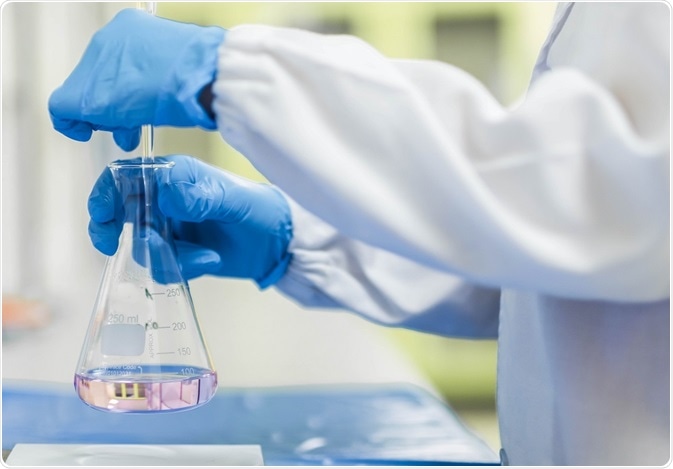Karl Fischer titration is a specialized type of titration, which is used to determine the water content of a product or substance. It differs from conventional titration as it uses different reagents, and is more accurate.
 Image Credit: Sukjai Photo / Shutterstock
Image Credit: Sukjai Photo / Shutterstock
What is titration?
Titration is an analytical chemistry technique used to find the concentration of an unknown solution, using a solution whose concentration is known. The latter is called the titrant and is usually contained in a buret, which allows its addition in a drop-by-drop manner for maximum accuracy of titration.
Titration is carried out on a known measure of the solution with unknown concentration, called the analyte, until the point of complete reaction of the two solutions. At this point the volume of the titrant is measured.
Using a known concentration, the quantity of the titrant used to completely react the analyte is calculated, and this in turn allows the determination of the concentration of the analyte in the known amount titrated.
The actual point when the reaction is completed is called the end point and often requires the use of an indicator to recognize it. This is frequently a color indicator which changes color at the point of equivalence.
The components of titration
The standard solution refers to the solution whose concentration is already known. A certain amount is added with great accuracy to the solution analyzed, the analyte, until the end point is reached.
The purpose of slow addition of the titrant to the analyte is to achieve accuracy of measurement which facilitates the calculation of the exact amount required to reach the point of equivalence with the analyte.
There are different methods of titration, such as:
- acid-base titrations to find the concentration of an unknown solution of acid or base
- redox titration to find the concentration of an oxidizing or reducing substance
- precipitation titrations and complexation titrations involving opposite ions and metal ions, respectively
Indicators
The indicators used to show when a redox titration attains equivalence are of three types:
- Automatic change in color of a titrant in reduced and oxidized state, such as permanganate which is deep purple in a basic solution, but is immediately reduced to manganese ions in acidic solution, turning colorless, makes it suitable for a titration of an acidic solution as the first tinge of purple shows equivalence has been attained
- Indicators sometimes form colored compounds when bound to a reduced or oxidized form of the titrant, such as starch which is capable of forming a dark blue-black compound with iodine
- Indicators which do not take part in the reaction but have different colors in the reduced and oxidized state, so that the appearance of color signals that the potential of the solution has changed as the titrant was added, and the end point has been reached
Karl-Fischer titration
This is a specialized titration used as the most specific method of water content determination in a substance. Thus, the unknown to be determined is the percentage of water, the titrant is a specialized one called the KF reagent, and the end point is the consumption of the water in the analyte. It is based upon the Bunsen reaction that involves iodine and sulfur dioxide reacting in an aqueous medium.
The modified reaction these days uses an alcohol, iodine, and sulfur dioxide with a buffer base. Water and iodine are consumed during this reaction in an equimolar reaction. The water comes solely from the sample, while the iodine functions as an indicator as well as taking part in the reaction. The special titrant used is the KF reagent.
The occurrence of excess iodine is detected using a double platinum indicator electrode whose conductivity drops steeply at the point of equivalence, besides the appearance of color because of the iodine. The KF reagent amount added to the analyte until this point is measured accurately and used to calculate the percentage of water in the substance.
Types of KF titration
This is performed in two ways:
- Volumetric, which depends upon the mechanical addition of iodine (in the KF reagent) from the buret to the analyte, and which uses the titer of reagent added to calculate the water content. It is ideally used to measure water estimated to be between 0.01 and 100% of a sample.
- Coulometric, which depends upon the generation of iodine in the analyte solution itself by an electrochemical process, and which uses the amount of current passed through the solution until the point of equivalence is reached to calculate the water percentage. It is capable of accurately measuring very small amounts of water in gases, for instance, between 0.0001 and 5% water content in the whole sample.
Further Reading